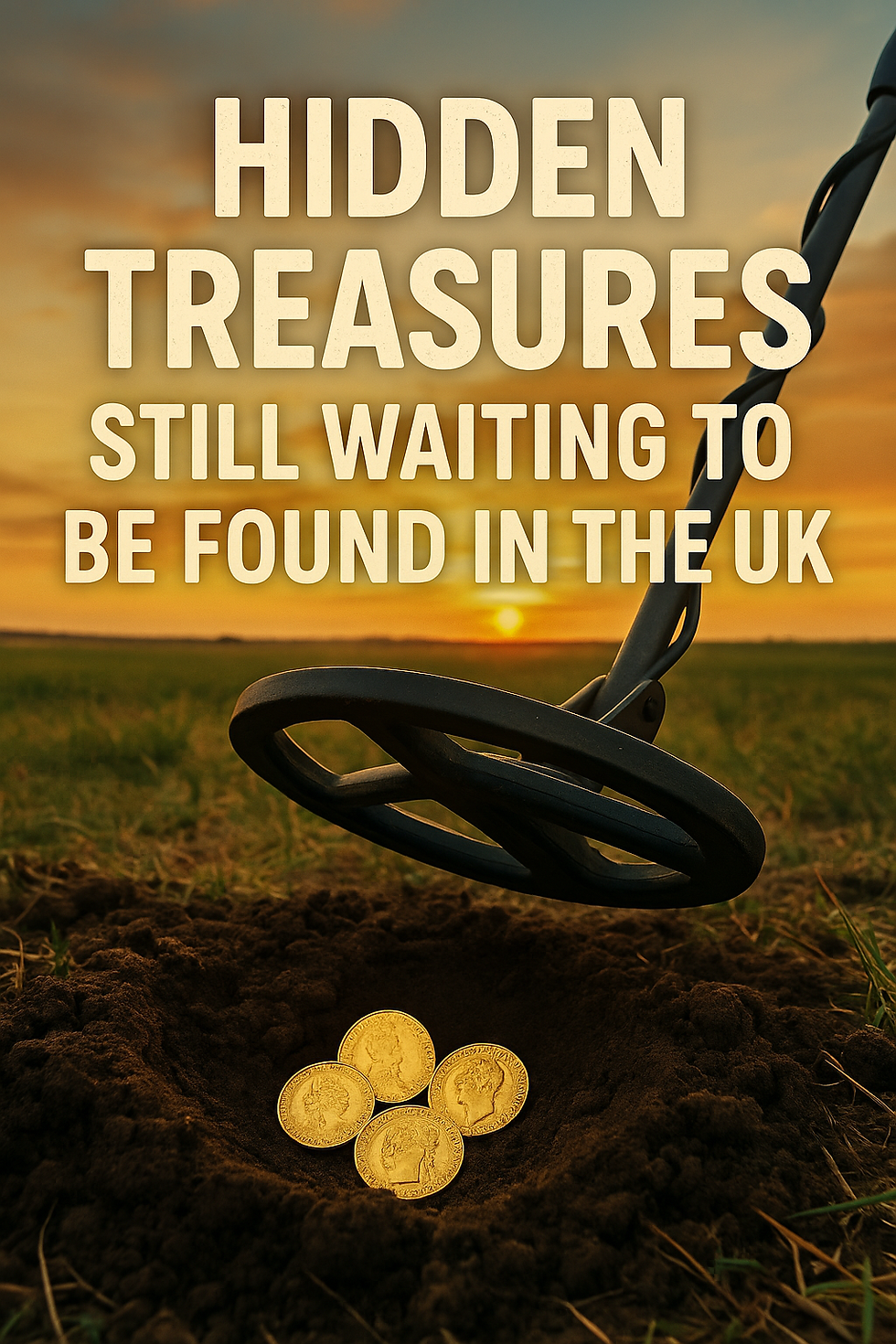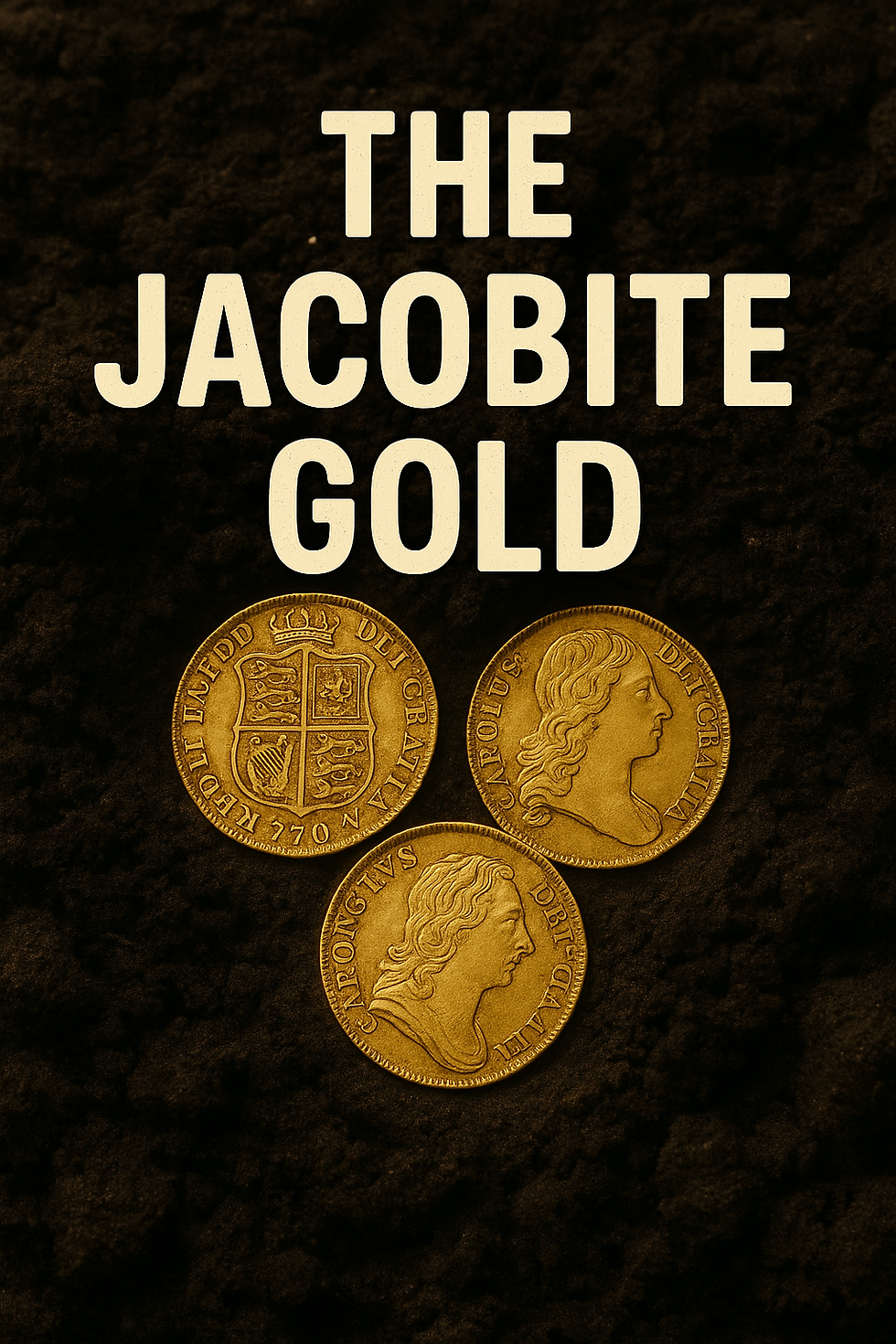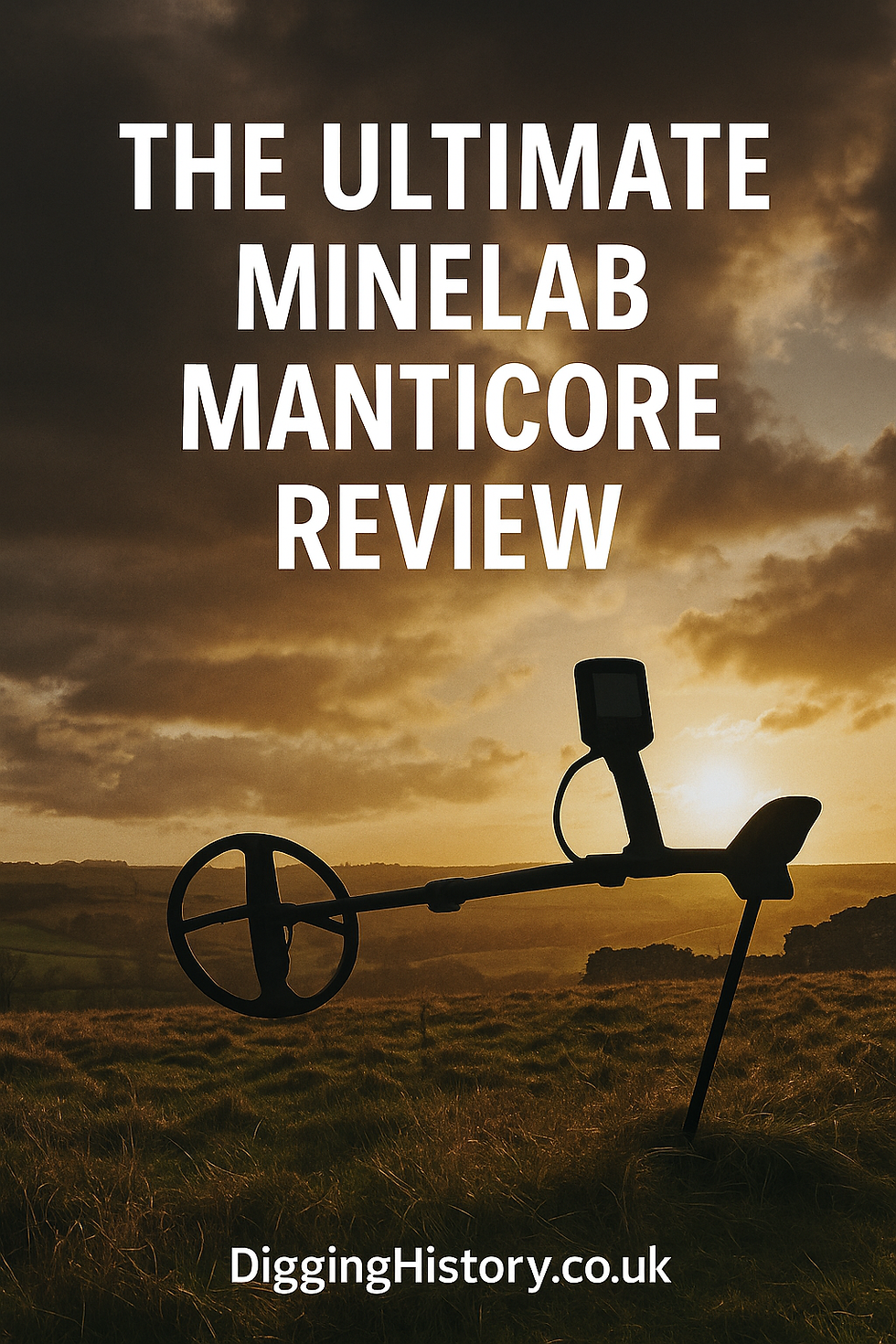Hidden Treasures Still Waiting to Be Found in the UK
- DiggingHistory.co.uk
- Oct 13
- 9 min read
Why the human urge to seek, save, and share the past still matters and how to do it legally, responsibly, and successfully.
The Human Urge to Hunt for the Past
Why do we keep searching? It isn’t only the glitter. It’s the story. Across Britain, farmers, walkers, detectorists, divers, archaeologists and sometimes kids on a wet weekend beach still encounter pieces of the past. We love the moment of discovery, the mystery of loss, and the shared pride when an object re-enters the public story.
But with that thrill comes responsibility. The UK’s archaeological record is finite. One careless dig can erase a chapter forever; one well-recorded find can rewrite a whole page of history.

First Things First: The Law (and Why It Protects the Stories)
England, Wales & Northern Ireland
Treasure Act 1996 and its Code of Practice set out what counts as treasure and how to report finds (England, Wales & NI).
Read the overview at the British Museum (they manage the Portable Antiquities Scheme, PAS):– Treasure & the PAS – British Museum British Museum
The most up-to-date Code of Practice (3rd Revision) is here (PDF):– Treasure Act 1996: Code of Practice GOV.UK
For responsible hobby practice, read:– Code of Practice for Responsible Metal Detecting (PAS) Portable Antiquities Scheme
Protected sites: Using a detector or removing objects on Scheduled Monuments without consent is a criminal offence under the Ancient Monuments and Archaeological Areas Act 1979.– Statute text for Section 42 (metal-detecting restrictions):legislation.gov.uk – 1979 Act, Section 42 Legislation.gov.uk– Historic England’s explainer and consent guidance:Section 42 Consent and PDF guidance Historic England
Scotland
Scotland has no Treasure Act. All portable antiquities are potentially claimable by the Crown under Treasure Trove; you must report all finds.– Guidance: Treasure Trove Scotland – Information for Finders and Historic Environment Scotland overview Treasure Trove
National bodies & landowners
National Trust: metal detecting generally not permitted except under specific research licence agreements.– Policy: National Trust – metal detecting National Trust
Crown Estate foreshore: a permissive right applies on some foreshore (between high and low water marks), subject to rules and the Treasure Act; Thames foreshore requires a separate PLA permit.– The Crown Estate – metal detecting & mud-larking and updated T&Cs (PDF) The Crown Estate – Port of London Authority – Thames foreshore permits pla.co.uk
Why this matters: The law doesn’t exist to spoil the fun; it exists to preserve context, the who/what/when/where that turns a shiny object into history.
Hidden Treasures In The UK vs. Hidden Truths: What’s Actually Still Out There?
Plenty. But facts and legends must be separated with care. Below are real, well-documented cases and what we truly know about their prospects.
1) King John’s Lost Baggage—The Wash (1216) (Legend with contemporary roots)

In October 1216, King John’s baggage train was reportedly lost to the treacherous tides of The Wash, along the Norfolk/Lincolnshire coast, when his route misjudged the incoming tide. Medieval chroniclers recorded the disaster; later histories embedded it in national memory. The existence and exact contents of the missing “crown jewels” cargo are still debated by historians, but no confirmed recovery has ever been made.
Read an evidence-based overview: History Today — King John’s Lost Treasure (2024). History Today
Scholarly context & debate summary: Wikipedia (with citations) — Lost jewels of John, King of England. Wikipedia
Reality check: The intertidal zone is dynamic; centuries of movement, silt, and saltwater make survival and discovery unlikely, but not impossible. If you’re anywhere near protected sites or sensitive habitats, you’ll need to abide by foreshore rules and avoid scheduled areas (see legal links above).
2) The Merchant Royal (1641), off Land’s End—“El Dorado of the Seas” (Well-evidenced, still undiscovered wreck)

The Merchant Royal (often called the Royal Merchant in records) reportedly sank in 1641 in rough weather off Land’s End while heavily laden with gold and silver bound for Flanders. The wreck’s exact position remains unknown, and periodic claims and searches have so far come to nothing.
Clear summary of the facts and status: History Channel (UK site) — The £1 billion lost treasure of the Merchant Royal. Sky HISTORY TV channel
Background and persistent search coverage: Yahoo UK (2024) — What we know about the hunt for the Merchant Royal. Yahoo News UK
Note: Salvage finds in 2007 widely rumoured to be the Merchant Royal are now generally considered a different wreck. Sky HISTORY TV channel
Reality check: UK wrecks may be protected under the Protection of Wrecks Act 1973—licences are required and sites can be restricted. Know the law before any marine detecting or diving:– Historic England – Protected Wreck Sites and the legislation baseline at legislation.gov.uk. Historic England
3) The Jacobite Gold—Loch Arkaig (1746) (Legend rooted in documented events)

Funds, gold coin specie, sent by France/Spain to support the Jacobite Rising were dispersed in the Highlands after Culloden (1746). The so-called Loch Arkaig Treasure is reputed to have been buried or hidden in the Lochaber region; its ultimate fate remains unclear.
Balanced summary: Loch Arkaig treasure (encyclopaedic overview with references). Wikipedia
Historical guidance (Scotland): Treasure Trove reporting requirements. Treasure Trove
Reality check: Scotland’s Treasure Trove system requires reporting of all finds and has additional restrictions on protected places and national forests/land. See: Historic Environment Scotland guidance and Forestry & Land Scotland policy (PDF). Historic Environment Scotland
4) The Lost Town of Dunwich—Suffolk (Archaeology beneath the waves, not a treasure hunt)

Dunwich, once a major medieval port, lies largely under the North Sea after storms and coastal change from the 13th century onward. Acoustic imaging and diver surveys have mapped ruins beneath the waves; it’s an extraordinary archaeological landscape rather than a place to seek personal treasure.
University-led research reported by The Guardian and others; overview with methods and findings: The Guardian+2Live Science
Reality check: Submerged towns aren’t treasure troves; they’re archaeological sites. Activities here are controlled and often require permissions/licences.
5) Storm-Tossed Coins and the Royal Charter—Anglesey (Occasional recoveries; strict wreck law applies)

The Royal Charter (1859) sank off Anglesey during the catastrophic “Royal Charter Storm,” with loss of life and large quantities of gold aboard (cargo and passengers’ private wealth). Divers and storms have occasionally revealed items and even a significant gold nugget nearby in modern times, but recovery is tightly regulated.
Where Treasures Tend to Hide: Reading British Landscapes
Even when there’s no headline “lost hoard,” Britain’s long, layered history means ordinary places can yield extraordinary finds, legally and ethically, with landowner permission and proper reporting.
Old routeways & crossings – Roman roads, fords, coaching inns, parish boundaries; people drop, hide, and lose things where they travel and transact.
Edges of old settlements – Modern villages often sit atop medieval (or earlier) footprints. Research historical maps to locate former greens, market plots, and “moved” churches.
Acre by acre of arable – Ploughing brings old metal to detectable depths; after heavy rain, soil moisture can improve signals.
Beaches & foreshores – Storms reshuffle sands. Follow Crown Estate and PLA rules, and avoid protected wreck sites. The Crown Estate pla.co.uk
Battlefield peripheries – Artefacts can scatter beyond mapped cores. Work with landowners and, ideally, archaeologists; the Battlefields Trust supports standards-based survey, not ad-hoc removing of evidence. Battlefields Trust
Research That Actually Works (and Wins Permissions)
PAS Database (England & Wales): Search known find-spots and artefact distributions to understand what turns up where.– Portable Antiquities Scheme – finds.org.uk and their advice PDFs. Portable Antiquities Scheme
Historic Environment Records (HERs): County-level datasets of known archaeology, useful for avoiding protected areas and understanding context. (Find via your county council or Historic England portals.)
Tithe, estate, and old Ordnance Survey maps: These show former field names, lost chapels, mills, and paths where loss/hoard behaviour clusters.
Clubs & landowner relations: The NCMD “basic rules of detecting” and sample permission agreements keep everyone on the same page.– NCMD Beginner’s Guide National Council for Metal Detecting
Top permission tip (human nature again): offer value, share maps, create a simple finds log for the farm, and promise PAS reporting. Reliability earns you long-term access.
Intertidal & River Truths: Mud, Magic and Permits
Crown Estate foreshore: permissive right in many places (not the seabed/river beds/other Crown lands). Follow Treasure Act obligations, respect local bylaws, and confirm where you stand.– Crown Estate page + 2024 T&Cs (PDF). The Crown Estate
River Thames (London): PLA permit required for mudlarking/searching/detecting; strict zones and rules apply.– PLA Foreshore Permits pla.co.uk
Wrecks & the Sea: Amazing, but Highly Regulated
Under the Protection of Wrecks Act 1973, certain sites are designated for their archaeological importance; visiting and especially disturbing them without a licence is unlawful.
Overview & licensing authorities:– Historic England – Protected Wreck Sites– Legislation text Historic England
If you encounter wreck material or find items at sea or on the shore that may derive from a wreck, you may have obligations to the Receiver of Wreck (GOV.UK guidance). GOV.UK
Ethics: Turning a Find into History (Not Just a Photo)
Get permission in writing (landowner/tenant).
Record precisely (GPS, soil context, depth when possible).
Report responsibly
England & Wales: PAS and the Treasure Act procedure. British Museum
Scotland: Treasure Trove—report everything of archaeological interest. Treasure Trove
Avoid protected places without formal consent (Historic England/Cadw/HES). Historic England
Think like a team-mate: Clubs, archaeologists, museums, everyone’s goal is to preserve the story.
Case Studies That Teach Good Habits
Hoard stories that changed knowledge (e.g., famous hoards like Hoxne or Staffordshire Hoard were responsibly reported and transformed our understanding). Even when a legend like King John’s treasure captivates, reality-minded detectorists focus on researchable landscapes where routine finds accumulate and the PAS record grows. (See PAS database for innumerable instructive examples.) Portable Antiquities Scheme
Battlefields & method: The Battlefields Trust emphasises that ad-hoc picking distorts evidence; in contrast, standardised surveys can map shot patterns and troop movements. The map—not the musket ball—often holds the historical gold. Battlefields Trust
Frequently Asked Questions
Is it legal to metal detect in the UK? Yes, with permission from the landowner and subject to national rules. England/Wales/NI follow the Treasure Act; Scotland follows Treasure Trove. Never detect on protected sites without consent.– Start with: PAS Code of Practice and Treasure Act Code; Scotland: Treasure Trove Finders. Portable Antiquities Scheme
Can I detect on beaches? Often yes but check ownership and local rules. Crown Estate foreshore has a permissive right (conditions apply), the Thames requires a PLA permit, and some beaches are private or protected. Crown Estate guidance & PLA permits linked above. The Crown Estate
What happens if I find “treasure”? Follow the legal process: report within the required time and work with the PAS (England/Wales/NI) or Treasure Trove (Scotland). Museums may acquire significant finds so they can be researched, conserved, and displayed.– Overview: British Museum – Treasure & PAS. British Museum
Are those famous “lost hoards” real? Some are documented events with unclear endings (e.g., Merchant Royal); others are legends with kernels of truth and centuries of retelling (e.g., King John’s baggage; Jacobite gold). Treat legends as inspiration, not maps. Sky HISTORY TV channel History Today
Can I detect on National Trust land? Generally no, unless part of an approved archaeological project under licence. Policy: National Trust – metal detecting. National Trust
Practical, Ethical Field Checklist (Printable)
□ Written permission from landowner/tenant
□ Checked HER/scheduled monument status and SSSI constraints
□ Read the PAS Code of Practice (England/Wales) / Treasure Trove guidance (Scotland)
□ Accurate location recording (GPS), photos, depth, soil notes
□ Bag/label finds separately; don’t clean aggressively before advice
□ Report: PAS FLO (England/Wales/NI) / Treasure Trove (Scotland)
□ Share a copy of your finds log with the landowner
A Note on Government Updates (Why this page stays honest)
The UK periodically updates Treasure/heritage guidance (e.g., government announcements to broaden the definition of treasure so more nationally important artefacts enter public collections). Always check the latest:– GOV.UK policy news on treasure rules: “Rules about discoveries are changed”. GOV.UK
Conclusion: The Treasure Is the Story
Hidden treasure in Britain is not only coins and gold, it's knowledge. The UK’s greatest riches are the stories recovered when finders, landowners, archaeologists and museums work together. The human psyche craves discovery, but our better nature insists we report, record, and share, so the next person doesn’t just see a shiny object; they see us.
Sources & Authority Links
British Museum / PAS:– Treasure & PAS overview: https://www.britishmuseum.org/our-work/national/treasure-and-portable-antiquities-scheme British Museum– PAS Code of Practice: https://finds.org.uk/getinvolved/guides/codeofpractice Portable Antiquities Scheme– General advice PDF: https://finds.org.uk/documents/advice.pdf Portable Antiquities Scheme
Legislation & regulators:– Treasure Act Code (England/Wales/NI): https://assets.publishing.service.gov.uk/media/64c909cb19f5622360f3c14a/Treasure_Act_1996__Code_of_Practice.pdf GOV.UK– Ancient Monuments & Archaeological Areas Act 1979 (Section 42): https://www.legislation.gov.uk/ukpga/1979/46/section/42/enacted Legislation.gov.uk– Historic England Section 42 consent guidance: https://historicengland.org.uk/advice/planning/consents/section42-consent/ and PDF guidance Historic England – Protected Wreck Sites (HE): https://historicengland.org.uk/listing/what-is-designation/protected-wreck-sites/ and Act text: https://www.legislation.gov.uk/ukpga/1973/33 Historic England – Scotland (Treasure Trove): https://treasuretrovescotland.co.uk/information/information-for-finders/ and HES guidance: https://www.historicenvironment.scot/advice-and-support/listing-scheduling-and-designations/finds-made-on-archaeological-sites/ Treasure Trove
Landowners & special cases:– National Trust policy: https://www.nationaltrust.org.uk/who-we-are/about-us/metal-detecting-on-national-trust-land National Trust– Crown Estate foreshore rules & T&Cs: https://www.thecrownestate.co.uk/our-business/marine/metal-detecting-and-drone-flying and 2024 T&Cs PDF The Crown Estate – PLA Thames foreshore permits: https://pla.co.uk/thames-foreshore-permits pla.co.uk
Case studies / history:– King John’s treasure: History Today (2024): https://www.historytoday.com/archive/missing-pieces/king-johns-lost-treasure and overview with sources: https://en.wikipedia.org/wiki/Lost_jewels_of_John%2C_King_of_England History Today+1– Merchant Royal background/status: https://www.history.co.uk/articles/the-ps1-billion-lost-treasure-of-the-merchant-royal-the-el-dorado-of-the-seas and hunt coverage: https://uk.news.yahoo.com/what-we-know-treasure-ship-gold-merchant-royal-cornwall-111037574.html Sky HISTORY TV channel – Dunwich underwater archaeology reporting: The Guardian & overview articles: https://www.theguardian.com/science/2013/may/10/archaeologists-map-suffolk-dunwich-sea ; background explainers: LiveScience / Wikipedia (marine archaeology section) The Guardian Live Science – Royal Charter storm/wreck: encyclopaedic background & storm page; Receiver of Wreck guidance: GOV.UK Wikipedia Wikipedia
If you chase headlines, you may end up disappointed, or worse, in court. If you chase knowledge, you’ll always find treasure. And sometimes, when you least expect it, Britain pays you back in gold and stories.
Thank You for Reading 🙏
Thanks for taking the time to read Hidden Treasures Still Waiting to Be Found in the UK. If you enjoyed it or learned something new, please share this article with fellow detectorists, history lovers, and anyone who appreciates Britain’s hidden past.
Every share helps keep DiggingHistory.co.uk growing, spreading the word about responsible metal detecting and keeping our shared history alive for future generations.





Comments